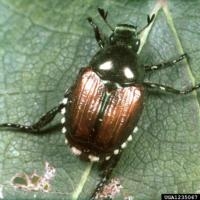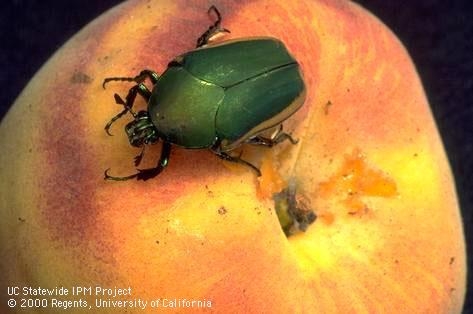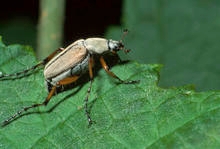- Author: Anne Schellman

Beetles are the most plentiful of all insects on the planet, so it's understandable to get a few of them confused. Let's compare photos and other details about each of these beetles, and also mention the green June beetle, a beetle that is commonly mistaken for the Japanese beetle.
Japanese Beetles

Japanese beetles do not have an established population in California. The California Department of Food and Agriculture* (CDFA) maintains traps for detecting this pest throughout the state. When Japanese beetles are found in California, they are targeted for eradication (complete elimination). Read more about this invasive species on the UC IPM website at https://ipm.ucanr.edu/Invasive-and-Exotic-Pests/Japanese-Beetle/
Green Fruit Beetles
Green fruit beetles are a dull green color and much larger than Japanese beetles. You may notice them in late spring and summer as they zoom around your garden. Fortunately, they are rarely a pest. https://ipm.ucanr.edu/PMG/GARDEN/FRUIT/PESTS/grfruitbeetle.html 
Rose Chafer Beetles
The rose chafer beetle resembles the hoplia beetle, however, this pest is not found in California. You can read more about these beetles on this informational page from University of Minnesota https://extension.umn.edu/yard-and-garden-insects/rose-chafers
Hoplia Beetles
Hoplia beetles are small, brown, and their undersides look like they've been dusted in gold. If you hold one in your hand, they will “play dead” and not move, making it easy to examine them.

You can read more details about managing hoplia beetles in the UC IPM Pest Notes: Hoplia Beetles.
*it's important that we help prevent invasive pests from taking hold in our communities and threatening agricultural crops. You can help by saying "yes" when trappers from the Agricultural Commissioner's Office ask if they can place traps in your landscape tree.
Anne Schellman is the Coordinator for the UC Cooperative Extension Master Gardener Program.
This article was originally published on May 8, 2023.

